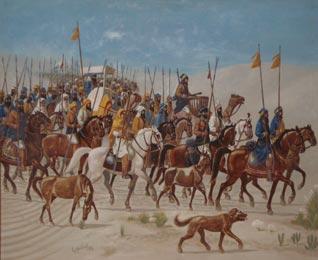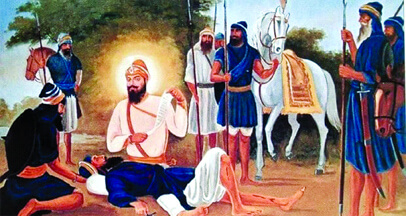Explore the historic rise of the Ruhilas from the Yusafzai tribe, establishing power between the Ganges and Kumaon hills in the 18th century.
Explore the rich history of Sikhs' relations with Mughal emperors, from spiritual meetings to persecution, highlighting resilience and transformation.
Explore the tumultuous interactions between the Sikhs and Nawab of Oudh amid alliances, raids, and British influence in this historical narrative.
Explore the pivotal 1762 battle of Vadda Ghallughara, a major holocaust in Sikh history, marking a fierce clash with Ahmad Shah Durrani.
AFGHAN SIKH RELATIONS spanning the years 1748 to 1849 go back to the first invasion of India by Ahmad Shah Durrani, although he must have heard of the Sikhs when in 1739 he accompanied Nadir Shah, the Iranian invader, as a young staff officer. Having occupied Lahore after a minor engagement fought on 11 January 1748 during his first invasion of India, Ahmad Shah advanced towards Sirhind to meet a Mughal army which he was informed was advancing from Delhi to oppose him. On the way he had two slight skirmishes at Sarai Nur Din and at the Vairoval ferry, both in present day Amritsar district, with a Sikh jatha or fighting band under Jassa Singh Ahluvalia.
BUDDHA DAL and Taruna Dal, names now appropriated by two sections of the Nihang Sikhs, were the popular designations of the two divisions of Dal Khalsa, the confederated army of the Sikhs during the eighteenth century. With the execution of Banda Singh Bahadur in 1716, the Sikhs were deprived of a unified command. Moreover, losses suffered by the Sikhs during the anti Banda Singh campaign around Gurdaspur and the relentless persecution that followed at the hands of `Abd usSamad Khan, governor of Lahore, made it impossible for Sikhs to continue large scale combined operations.
CHALI MUKTE, lit. forty (chalf) liberated ones (mukte), is how a band of 40 brave Sikhs who laid down their lives fighting near the dhab or lake of Khidrana, also called Isharsar, on 29 December 1705 against a Mughal force in chase of Guru Gobind Singh are remembered in Sikh history and daily in the Sikh ardas or supplicatory prayer offered individually or at gatherings at the end of all religious services. Guru Gobind Singh, who had watched the battle from a nearby mound praised the martyrs` valour and blessed them as Chali Mukte, the Forty Immortals. After them Khidrana became Muktsar the Pool of Liberation.
CHHOTA GHALLUGHARA, lit. minor holocaust or carnage, as distinguished from Vadda Ghallughara (q.v.) or major massacre, is how Sikh chronicles refer to a bloody action during the severe campaign of persecution launched by the Mughal government at Lahore against the Sikhs in 1746. Early in that year, Jaspat Rai, the faiydar of Eminabad, 55 km north of Lahore, was killed in an encounter with a roving band of Sikhs. Jaspat Rai\'s brother, Lakhpat Rai, who was a diwan or revenue minister at Lahore, vowed revenge declaring that he would not put on his head dress nor claim himself to be a Khatri, to which caste he belonged, until he had scourged the entire Sikh Panth out of existence.
FATUHAT NAMAH-I-SAMADI, an unpublished Persian manuscript preserved in the British Library, London, under No. Or. 1870, is an account of the victories of `Abd us-Samad Khan. Nawab Saifud Daulah `Abd usSamad Khan Bahadur Diler Jang was appointed governor of the Punjab by the Mughal Emperor Farrukh-SIyar on 22 February 1713, with the specific object of suppressing the Sikhs who had risen under Banda Singh commissioned by Guru Gobind Singh himself, shortly before his death, to chastise the tyrannical rulers of Punjab and Sirhind.
FATEHNAMAH, by Bhai Dyal Singh, is a versified account of the victory (fateh, in Persian) of the Sikhs in the battle fought on Sunday, 22 Baisakh 1854 Bk/30 April 1797, against Shah Zaman`s forces led by one of his generals Ahmad Khan, also called Shahanchi Khan, in which the latter got killed and his forces fled the field. Nothing is known about the poet who, judging from his diction, belonged to the western parts of the Punjab. The poet showers special praise on the Sikh warrior.
- 1
- 2









